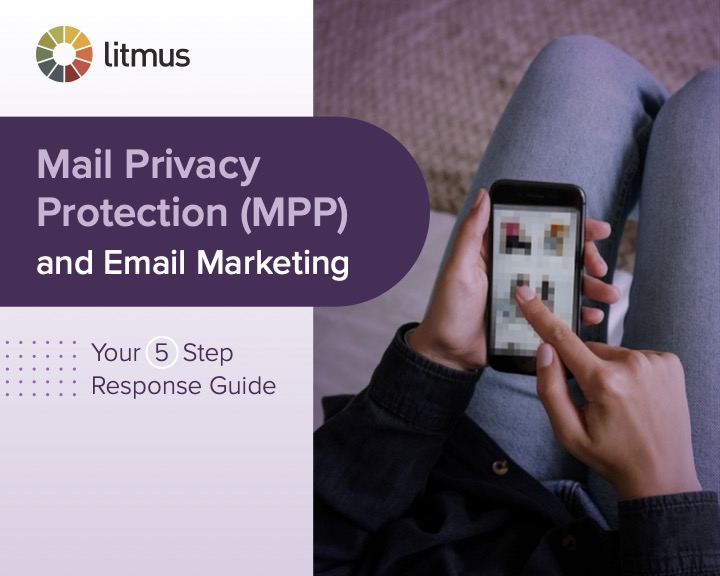MPP in Email Marketing: Myths, Facts and Your Response
The email marketing community swirled with speculation about the possible impact of Apple’s Mail Privacy Protection (MPP) leading up to its release in the fall of 2021.
Now, MPP is part of every email marketer’s reality. (And if you’re inexplicably seeing record high open rates and not sure why, this may be the perfect time to get up to speed on all things MPP).
The Litmus engineering team was testing how MPP in email marketing would work—and how it would impact different programs and metrics—before its release. Now more than eight months after the fact, we’re still watching it closely.
The best part? We now have some answers about MPP that we think every email marketer will find helpful.
Claim your copy of our latest ebook “MPP and Email Marketing: Your 5 Step Response Guide.” You’ll learn what we know about MPP’s impact in email marketing—and our recommendations for how you may want to respond.
Read on for highlights of some of the developments we’re seeing when it comes to MPP in email marketing, and answers to a few commonly asked questions the Litmus community has posed.
MPP adoption keeps climbing
Litmus’ email client market share data shows the Apple Mail client—on iPhone, Mac, and iPad devices—with nearly 60% of combined email opens as of April 2022. It’s the most popular email client by a significant lead.
In October 2021, shortly after MPP was released, Litmus Email Analytics data indicated that 14.35% of Apple opens were impacted by Apple Mail Privacy Protection.
By December 2021, that number had jumped to 41%. As of May 2022, the number of MPP impacted opens has exceeded 50%.
More email service providers are accommodating MPP opens
The actual impact MPP in email marketing has on any program depends on how many Apple Mail users who have opted into MPP are on the marketer’s list. Understanding what portion of your subscriber base uses Apple Mail today—and how many are opted into MPP—is your first step to forming how to best respond.
Email Analytics makes it easy to see how your specific email program is impacted by MPP, and a handful of email service providers (ESPs) have started to introduce data filtering to account for false email opens, too.
Email marketers are trying new tactics
Since MPP makes it impossible to know whether a subscriber is really opening the email (or not!), measuring true engagement with content intended to capture “signs of life” from a subscriber has become more important than ever. Polls, gamified experiences, links, and a simple “thumbs up” are all great ways to encourage engagement.
We’ve also started to see some email marketers come right out and ask subscribers to click if they’re truly interested in remaining on the list.


Work with (not against) MPP
Some Litmus users have come to the Litmus Customer Support team with questions related to the activity MPP really masks. For example, we’ve heard questions about whether MPP might offer “tells” that reveal when open rates reflect actual human interaction. Spoiler alert: there are none. That’s why we group all of them under the Apple privacy-impacted opens group. And remember, MPP is a privacy measure that subscribers opt into by choice. We as email marketers have a duty to respect those wishes.
Email Analytics users have also asked us whether MPP opens can still collect individual-level data, such as contact IDs or custom parameters. That answer is yes!
With merge tags and our custom parameters field, you can collect additional data about your opens. Your custom parameter can be a campaign code, web analytics code, or another merge field from your messaging platform or ESP.
You may want to reimagine A/B subject line testing
Now that we know some MPP-impacted opens aren’t reliable, what’s the fate of the A/B subject line test? This a commonly asked question from many of our Litmus users.
Cynthia Price, Senior Vice President of Marketing at Litmus, says one option is to find a segment that isn’t impacted and use it as a proxy—but acknowledges that type of segmentation isn’t possible for everyone.
To overcome the challenge, Jaina Mistry, Senior Email Marketing Manager at Litmus, recommends a new approach: Rethink the goal of your subject line entirely. “Rather than just trying to get an open, you want subscribers/readers to take action. In that case, measuring click-through rate or conversion rate when A/B testing subject lines is an option.”
To make that an effective test, Mistry says email marketers will need to invest real effort into making both the subject line and preview text actionable. In cases where this approach isn’t appropriate, it may simply be time to stop relying on A/B testing subject lines and open rates as a cut-and-dry measure of success.
Ready to get up to speed on all the latest happenings related to MPP? Grab your guide now!

| Mail Privacy Protection (MPP) and Email Marketing: Your 5 Step Response Guide Get up to speed on what MPP means for your email strategy, including how to evaluate its impacts on your audience so far, campaign strategies to pivot in light of MPP, and ways to re-evaluate email performance |

Stephanie Christensen
Stephanie Christensen was the Director, Content Marketing at Litmus
